Measurement Feedback Self-Tuning Weighted Measurement Fusion Kalman Filter for Systems with Correlated Noises
Abstract
For the linear discrete stochastic systems with multiple sensors and unknown noise statistics, an online estimators of the noise variances and cross-covariances are designed by using measurement feedback, full-rank decomposition, and weighted least squares theory. Further, a self-tuning weighted measurement fusion Kalman filter is presented. The Fadeeva formula is used to establish ARMA innovation model with unknown noise statistics. The sampling correlated function of the stationary and reversible ARMA innovation model is used to identify the noise statistics. It is proved that the presented self-tuning weighted measurement fusion Kalman filter converges to the optimal weighted measurement fusion Kalman filter, which means its asymptotic global optimality. The simulation result of radar-tracking system shows the effectiveness of the presented algorithm.
1. Introduction
With the development of scientific technology, the scale of a control system has become more and more complex and tremendous, and the accuracy, fault-tolerance, and robustness of a system are required much higher, so that single sensor has been unable to satisfy the demands of high scientific technologies. Thus, the multisensor information fusion technology has been paid great attention to and become an important research issue.
In early 1980s, Shalom [1, 2] presented the computation formula of cross-covariance matrix by studying the correlation of two sensor subsystems with independent noises. Carlson [3] presented the famous federated Kalman filter by using the upper bound of noise variance matrix to replace noise variance matrix and supposing that the initial local estimation errors are not correlated. Kim [4] proposed the maximum likelihood fusion estimation algorithm by requiring the hypothesis that random variables obey normal distributions. The universal weighted least squares method and the best linear unbiased fusion estimation algorithm were presented by Li et al. [5] on the basis of a unified linear model for three estimation fusion architectures of centralized filter, distributed filter, and hybrid filter. Three weighted fusion algorithms of matrix-weighted, diagonal-matrix-weighted, and scalar-weighted in the linear minimum variance sense were proposed by Sun and Deng [6], Sun [7], where the matrix-weighted fusion algorithm, maximum likelihood fusion algorithm [4], and distributed best linear unbiased estimation algorithm [5] have the same result and avoid the derivation on the basis of hypothesis of normal distribution and linear model. The shortcomings of methods presented in [3–7] are that they have larger calculation burdens and the fusion accuracy is global suboptimal.
Based on Kalman filtering, Gan and Chris [8] discussed two kinds of multisensor measurement fusion method: the centralized measurement fusion (CMF) and the weighted measurement fusion (WMF). The former is to directly merge the multisensor data through the augmented measurement vector to calculate the estimation. Its advantage is that it can obtain globally optimal state estimator. Its shortcoming is that the computational burden is large since the measurement dimension is high. So it is unsuitable for real-time application. The latter is to weigh local sensor measurements to obtain a low-dimensional measurement equation, and then to use a single Kalman filter to obtain the final fused state estimation. Its advantages are that the computational burden can be obviously reduced and the globally optimal state estimation can be obtained [8–12].
It is known that the existing information fusion Kalman filtering is only effective when the model parameters and noise statistics are exactly known. But this restricts its applications in practice. In real applications, the model parameters and noise statistics are completely or partially unknown in general. The filtering problem for systems with unknown model parameters and/or noise statistics yields the self-tuning filtering. Its basic principle is the optimal filter plus a recursive identifier of model parameters and/or noise statistics [13].
For self-tuning fusion filters, there are two methods of self-tuning weighted state fusion and self-tuning measurement fusion. Weighted state fusion method is used by Sun [14] and Deng et al. [15], respectively, but the used distributed state fusion algorithm is globally suboptimal and the acquired self-tuning estimator cannot reach globally asymptotic optimality. For the self-tuning measurement fuser, [9, 16] considered the uncorrelated input noise and measurement noise. Ran and Deng [17] presented a self-tuning measurement fusion Kalman filter under the assumption that all sensors have the same measurement matrices.
This paper is concerned with the self-tuning filtering problem for a multisensor system with unknown noise variances, different measurement matrices, and correlated noises. Firstly, transform the system with correlated input noise and measurement noise into one with uncorrelated input noise and measurement noise by using the measurement feedback and taking measurement data as a part of system control item. Then, weigh all the measurements by using full-rank decomposition and weighted least squares theory. The Fadeeva formula is used to establish ARMA innovation model with unknown noise covariance matrices and the sampling correlated function of a stationary and reversible ARMA innovation model is used to identify the noise covariance matrices. It is rigorously proved that the presented self-tuning weighted measurement fusion Kalman filter converges to the optimal weighted measurement fusion Kalman filter, that is, it has asymptotic global optimality.
2. Problem Formulation
Assumption 2.1. w(t) and vi(t) are correlated Gaussian white noise with zero means, and
Assumption 2.2. (Φ, H(I)) is a detectable pair and (Φ, Γ) is a controllable pair, or Φ are stable.
Assumption 2.3. Measurement data yi(t) is bounded, that is,
2.1. CMF and WMF Kalman Filter
For systems (2.4) and (2.7), and (2.7) and (2.11), respectively, using standard Kalman filtering algorithm [20], we can obtain CMF and WMF Kalman estimators , i = I, II, j = 0, j < 0, and j > 0, and their error variance matrices P(i)(t∣t + j). It is proved in [11] that the weighted measurement fusion steady-state Kalman filter for the weighted measurement fusion system (2.7) and (2.11) has the global optimality, that is, it is numerically identical to the CMF steady-state Kalman filter if they have the same initial values.
The above WMF method can obviously reduce the computational burden since the dimension of the measurement vector for the centralized measurement fusion is m × 1, m = m1 + m2 + ⋯+mL, while that for the weighted measurement fusion is r × 1, and m is much larger than r generally.
2.2. Optimal Measurement Fusion Steady-State Kalman Filter
When noise variance matrices Qw, Si, and Rij(i, j = 1, …, L) are unknown, the problem is to find a self-tuning WMF Kalman filter for the fused system (2.7) and (2.11). Then, the key to the problem is how to find the consistent estimates of the noise variance and cross-covariance matrices Qw, Si, and Rij.
3. Online Estimators of Variances and Cross-Covariances
Lemma 3.1 (matrix inverse Fadeeva formula [13]). The matrix inverse formula is given by
Theorem 3.2. For the ith subsystem of systems (2.1) and (2.2) under the Assumptions of 2.1, 2.2, and 2.3, the innovation model of CARMA
Proof. From (2.1) and (2.2), we have
Remark 3.3. When the noise variances Qw and Ri are known, the Gevers-Wouters [20] algorithm can be used to construct ARMA innovation model and obtain Di(q−1) and .
In (3.14), zi(t) is a stationary stochastic process, whose correlated function has cut-off property, and suppose it be cut-off at , that is,
At the end of time t, the sampling estimation of the correlated function based on measurements (zi(t), zi(t − 1), zi(t − 2), …) can be defined as
Computing the correlated function on both sides of (3.14), we have
However (3.19) is a matrix equations set. Substituting the sampling estimates at the time t into (3.19), and solving the matrix equations set, then we have the estimates , , and at the time t.
From the ergodicity of the stationary stochastic process (3.14) and the Assumption 2.3, when t → ∞, we have , and .
4. Self-Tuning WMF Kalman Filter
When the statistical features of the noise are unknown, the self-tuning weighted measurement fusion Kalman estimator can be obtained through the following three steps.
Step 1. For different sensor systems, (3.16)– (3.19) are used to identify online the estimates , , and , of noise variances of Qw, Rij, and Si at the time t, which will yield the following available estimates at the time t:
Step 2. From (2.15), solving the following Riccati equation, we get the estimation value of Σ(II) at the time t:
Step 3. Equations (2.14) are applied, and the self-tuning weighted measurement fusion state estimator is given by
Remark 4.1. At every moment, the iteration method to solve Riccati equation (4.2) causes comparatively large computation burden, which is not convenient for the real applications. To reduce the computational burden, a computing period (dead band) Td of (4.2) is set and the estimation value keeps invariant in the period Td. So, is only computed at the moments of t = Td, 2Td, 3Td, …, which can reduce computation burden, and can be called Riccati equation with a dead band [9, 17].
5. Simulation Example
When ρi, Qw and are unknown, the problem is to find the self-tuning WMF α − β tracking filter .
The parameter convergence results of subsystem 1 are shown in Figures 1, 2, 3, 4, and 5, and the parameter convergence results of subsystem 2 are shown in Figures 6, 7, 8, 9, and 10, where the curved lines denote the estimates and the straight lines denote true values. The self-tuning WMF Kalman filter is shown in Figures 11, 12, 13, 14, and 15, where Figure 11 is the convergence of . Using the iteration algorithm with dead band Td = 200, we can see that the parameter estimates in shown in ladder-shape curves converge to the corresponding real values.
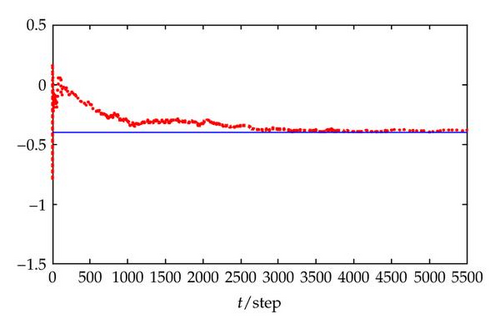
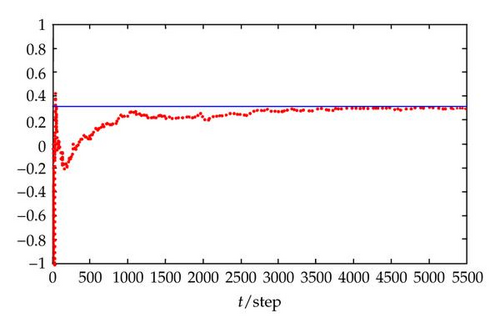
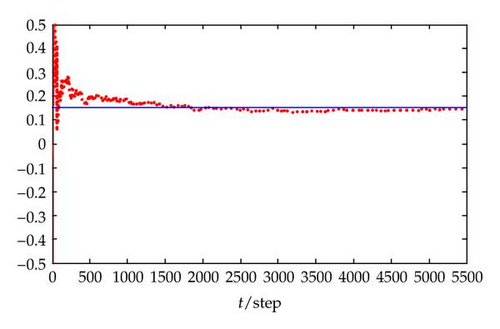
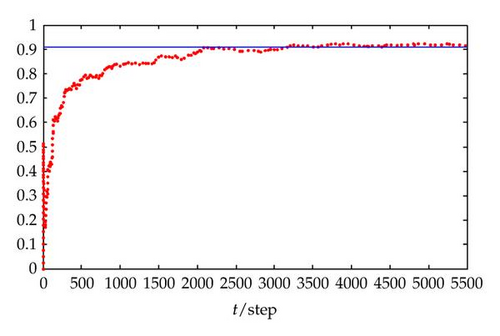
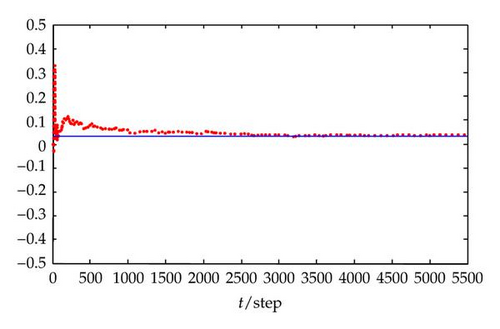
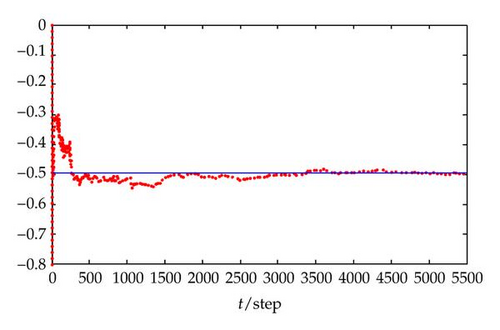
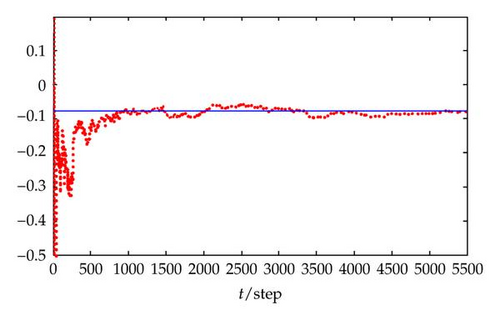
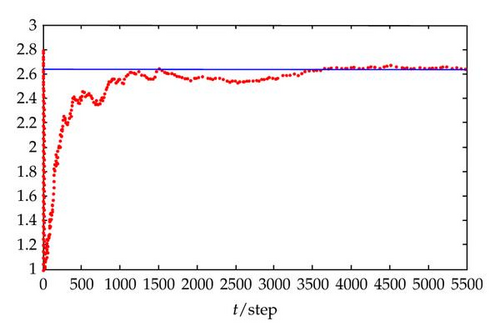
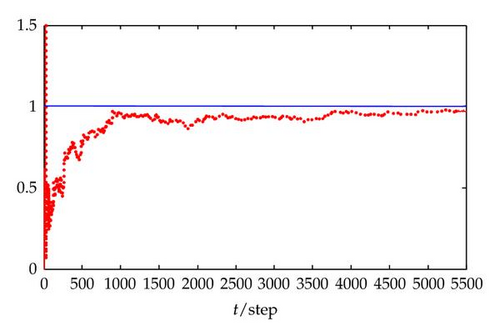
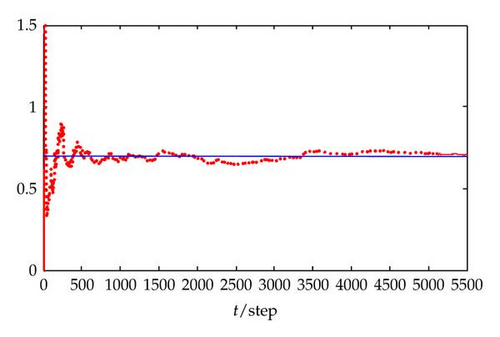
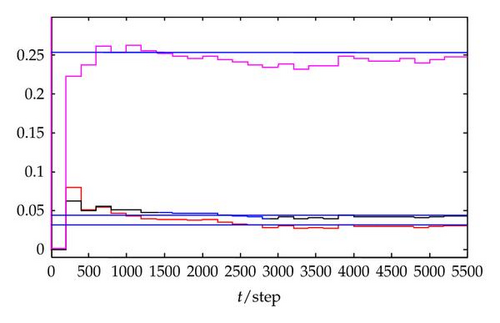
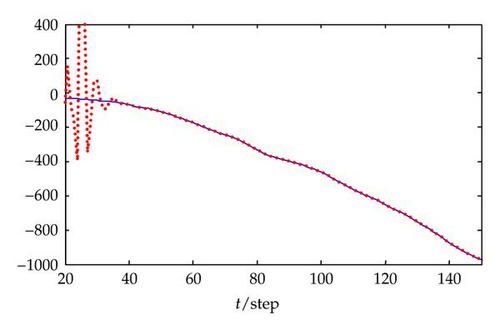
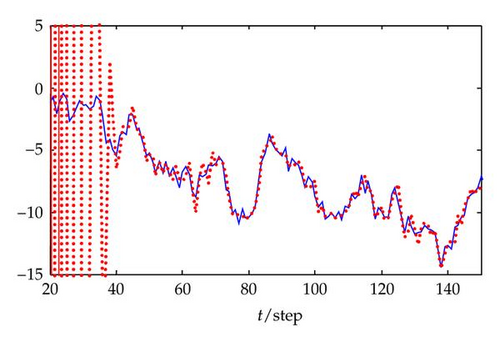
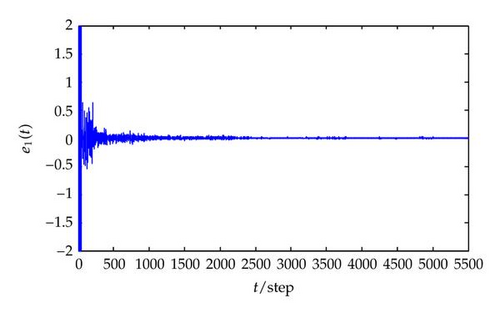
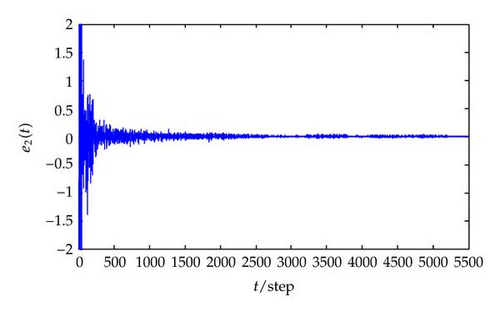
The object-tracking curves of self-tuning WMF Kalman filter is shown in Figures 12, 13, 14, and 15. We can see that the system can gradually track the position and speed of the objects as the time increases, where the real lines are real values and the dashed lines are estimates. The error curves between the optimal and self-tuning WMF Kalman filter is shown in Figures 14 and 15. We see that the error curves take on the funnel shape, which demonstrates that the self-tuning filter has better convergence.
6. Conclusion
For multisensor linear discrete time-invariant stochastic control system with different measurement matrices and correlated noise, an online identification method is designed when the input noise and measurement noise variance are unknown. It firstly uses Fadeeva formula to construct ARMA innovation model with unknown noise covariance matrices, and then uses the ergodicity of sampling-correlated function in the stationary and inverse ARMA innovation model to identify the noise covariance matrices. Further, a self-tuning WMF Kalman filter has been presented from a steady-state global optimal measurement fusion Kalman filter by matrix full-rank decompostion, weighted least squares method, and measurement feedback. It has asymptotic global optimality. Compared to the centralized fusion algorithm, it can reduce the computational burden.
Acknowledgments
This work is supported by National Natural Science Foundation of China under Grant NSFC 61174139, Key Project of Chinese Ministry of Education under Grant 209038, Key Laboratory of Electronics Engineering, College of Heilongjiang Province under Grant DZZD 20100038, Science and Technology Research Foundation of Heilongjiang Province Education Department under Grant 12521420, Open Laboratory Project of Heilongjiang University in China 2012, and High Level Talents Support Project of Heilongjiang University in China under Grant Hdtd2010-03.




